We're very excited about this one: FreePlay Duo for the first time in Asia!
So far, the following events are booked, with a few others likely:
Jan 7 – Workshop at St. Xavier College, Mumbai, India
Jan 10 – Workshop at Mahindra United World College, Pune, India
Jan 10 – Concert at Mahindra United World College, Pune, India
Jan 13 – Radio appearance, 938Live, Singapore
Jan 13 – Concert at Ngee Ann City, Singapore
Jan 16 – Concert at Arts House, Singapore

Thanks to the Ontario Arts Council for their generous support of this tour. There is no way that we (or our international presenters) could have made this a reality without the Ontario Arts Council's support, and for that, we are so grateful.
Tour Blog
Dylan and Suba just got home from our tour of India, Singapore, and Bali. Check out our travels here on our blog! Fasten your seatbelts… here we go.
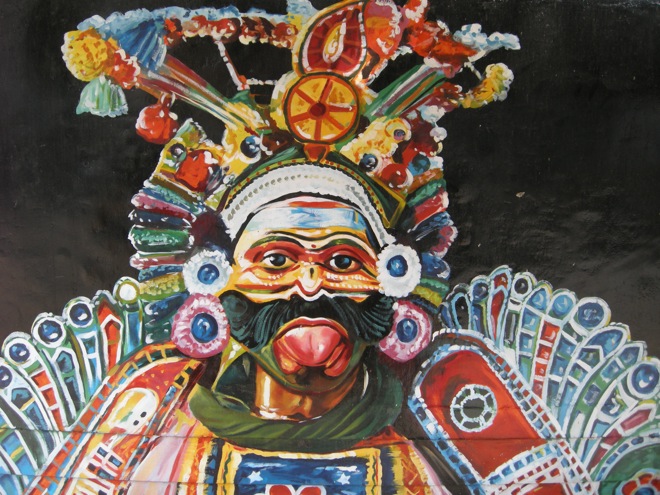
He's not making fun of you. He's sort of like a Gargoyle: he scares off the evil spirits. An auspicious way to start.
Chapter 1: Chennai (formerly Madras)
It’s a pretty long flight to India. How long? Put it this way… we left on New Year’s Eve, and arrived on Jan 2! Fortunately, our flights were uneventful – no volcanoes or other natural disasters like our trip to Europe in May.
We flew to Chennai via Dubai. Dubai airport is huge and impressive. Tons of gold sellers – first time I’ve ever seen a gold bar in real life — and a beautiful mini-park in the middle of the terminal.
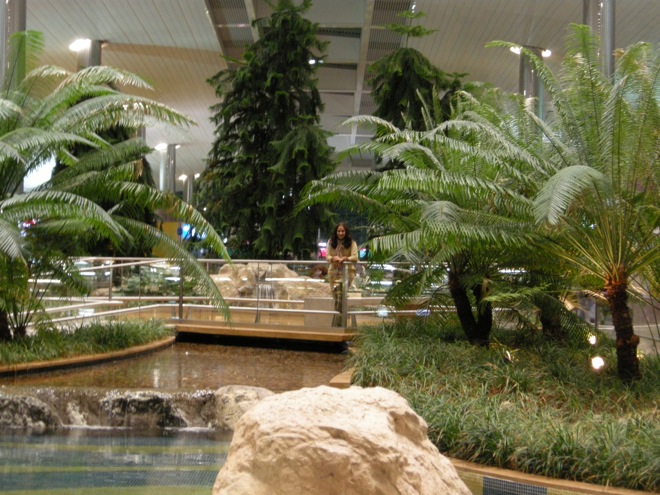
… and of course, the “usual suspects” of airport fast-food…

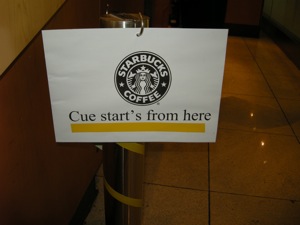
The best part… for the second part of the flight, we were bumped up to Business Class. It was pretty sweet: fully-reclining seats (really… all the way to lying-down), champagne and fine wines, and restaurant-style food. It was the only time we’ve ever wished a flight could be longer!

Our stay in Chennai was relaxing, and a good way to start the trip, recover from jetlag, and acclimatize to India. India is an assault on the senses in all ways possible. It’s loud, colourful, and full of contrasts and contradictions.
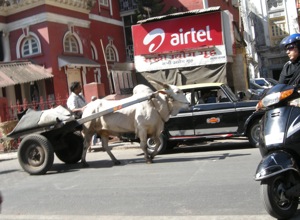
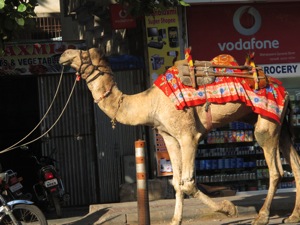
Walking on the “sidewalks” (such as they are, and wherever they appear) is an obstacle course, and crossing the chaotic streets means taking your life into your own hands. It’s worth a little prayer to the Gods: fortunately, in India, you can take your pick…

Speaking of the Gods, we visited the Basilica of Saint Thomas (known here as “Santhome”). This is Thomas the Apostle, and his remains are buried under the church: one of only three churches in the world built over the tomb of an Apostle. As we were exploring, we witnessed the end of a Mass… spoken and sung in Tamil.
We spent some time with Suba’s parents, who live in Toronto but come back to Chennai every year. Dr. Sankaran is a world-renowned master of the mrdangam: December/January is the high concert season, and Dr. Sankaran performs dozens of concerts. We were lucky enough to catch one, featuring vocalist Vijay Siva.
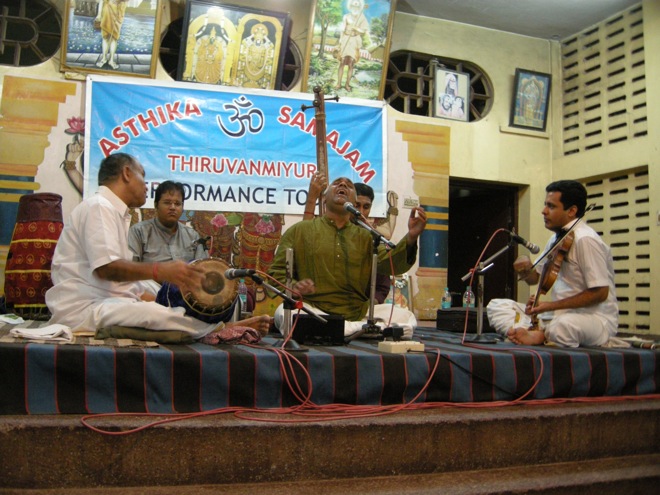
The rest of our time was spent shopping, walking on the beach, and visiting family.
Chapter 2: Mumbai (formerly Bombay)
If Chennai was slow and relaxing, Mumbai was short but intense: our 48-hour stay felt like a week. When we first arrived, we reunited with Autorickshaw member Ed Hanley, who has been in India since December for intensive tabla studies. We caught up, did a little shopping, and sampled some of Mumbai’s amazing cuisine.
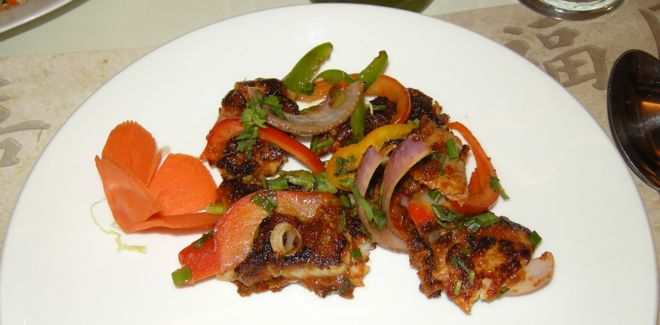
Mumbai is a fascinating city, at once cosmopolitan and traditionally Indian. Unlike the predominantly-Hindu South, Mumbai is a mishmash of Hindu, Islamic, and British colonial influences, with a little dab of Western big-city vibe and Bollywood flair (this is Ground Zero for the Hindi film industry: the name “Bollywood” is a combination of “Bombay” and “Hollywood”). Unfortunately, this can be an uneasy mix. Mumbai suffered major terrorist attacks in 2008, and there was a serious (but unrealized) terror threat just before we arrived. The evidence is everywhere: X-ray machines and metal detectors at upscale hotels and tourist sites, and the occasional bunkered soldier with a sniper-style rifle on major street corners and train stations. But the feeling in the streets is not tense: Mumbai is resilient, and most people here just carry on.

The next day was packed with activity. We started by visiting the famous Crawford Market (a covered food market, with fountains built by Rudyard Kipling’s father), followed by some crazy street-markets nearby.
Next up was a vocal workshop at Xavier College, a Jesuit school founded in 1869. This was our first-ever choral workshop in India, and we were fascinated to see how it would go: Indian music has no harmony, and there is no real “choral tradition” in India. The choir’s director, Virgil Sequeira, has been finding and teaching choral repertoire that fuses Indian music with choral techniques. He discovered Suba’s Indian/choral fusion piece “Vara Sapta Swara” and contacted Suba. One thing led to another: the Xavier College Chorus recorded Suba’s composition, and we found ourselves in Mumbai working with them face-to-face.
We found it interesting to see how our workshop material was received. The kids were fantastic and enthusiastic, and learned very quickly, especially the rhythmic material. Indian music is taught by rote and is much more rhythmically based than Western music, so what is often challenging to Western choirs was second-nature to these students. While Indian vocals are incredibly complex, there is little focus on actual vocal production, so they were eager to learn about Western vocal techniques. We had a wonderful time with the students, and thank Virgil for inviting us to work with them.
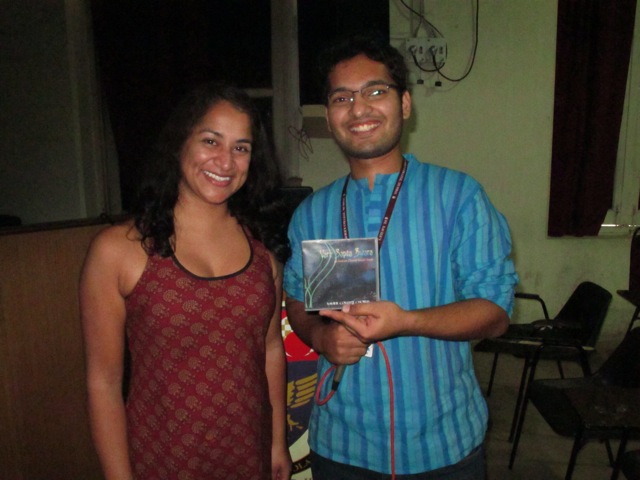
Our final night in Mumbai started with a classic Mumbai pastime: eating pav bahji on Chowpatty Beach. We then walked along the boardwalk (known as the Queens Necklace for the city lights and curving shoreline) to finish off with a nightcap at the Intercontinental Hotel’s rooftop bar, The Dome. All-in-all, a day well-spent.
When it comes to India, a picture’s worth a thousand words, so click here to see a photo gallery.
Up next… Chapter 3: Pune. Read on as Ed, Suba and Dylan see giant bats, get lost in hippyville, and perform at the Mahindra United World College.
Chapter 3: Pune
The next day saw us taking a train to Pune. Pune is only 150km away from Mumbai, but the train takes four hours. Here’s why:
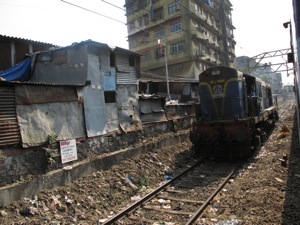
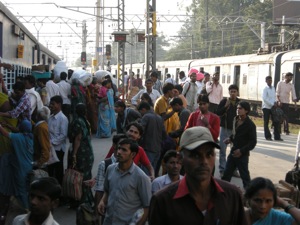
We eventually got there and settled into Ed’s apartment, a nice place with a beautiful balcony view.
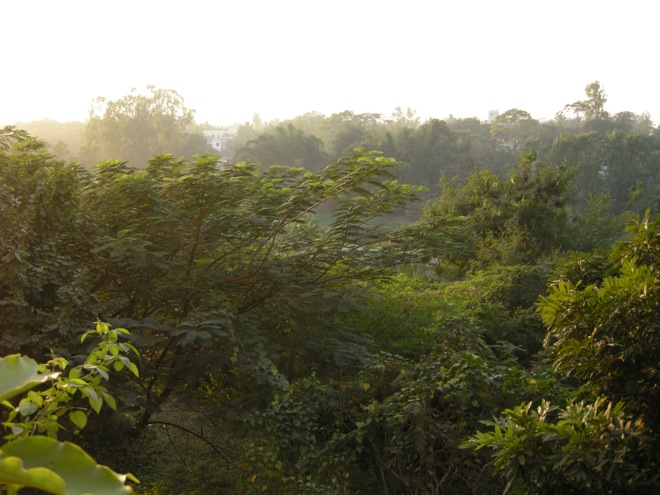
As the sun set, all sorts of birds came out: swallows, geese, big guys that looked like falcons… it was lovely. Until we saw this:
It turns out that this is a giant fruit bat, aka a “flying fox”. Their wingspan can be up to four feet wide. Fortunately they eat mangoes, not people… but we’re pretty sure we heard a distant “mwah-ha-ha-ha-haaaaa!” as we scrambled inside.

The next day was all about getting lost. Dylan found himself a map of Pune for his iPod… it was pretty much useless. Many streets in Pune don’t even have names, and so directions are given using landmarks. More importantly, many local folks don’t seem to know where things are… not that they’d tell you that. We spent about an hour and a half walking back and forth, looking for a particular vegetarian restaurant. Good news: we eventually found it. Bad news: “Sorry sir, it’s closed. For the year.” This gentleman gave us another recommendation, which took another hour – and four different, conflicting “suggestions” from people on how to get there. Fortunately, the food was worth it… even if it was a bit spicy.

It’s worth a quick digression to discuss the infamous Indian “head-waggle”. The Waggle is sort of the Indian equivalent of nodding – just side-to-side, rather than up and down. Its meaning is subtle and layered. So far, we’d discovered that The Waggle can mean the following:
1. Yes
2. No
3. Maybe
4. Like, whatever
5. I'm pretty sure you're an idiot, sir
Moreover, Indians don’t always like to respond to questions negatively, so asking directions goes something like this.
– “Excuse me sir, can you tell me how to get to [name your destination]”?
– [head waggle]
– “so, which way”?
– [head waggle, followed by vague pointing]
– “is that left or right on this street?”
– [head waggle]
… well, you get the picture.
The next day was a workshop and concert at the Mahindra World College of India. The College is high up on a mountaintop, in a nature reserve… a beautiful place for the 200 students to live and learn. If we ever have kids, we’ll send them to a place like this… and get a teaching gig there while we’re at it!

We gave an informal workshop to a small but enthusiastic crowd. The students are hand-picked from all over the world, and it shows: the audience was a truly multicultural mix, with excellent, intelligent questions.
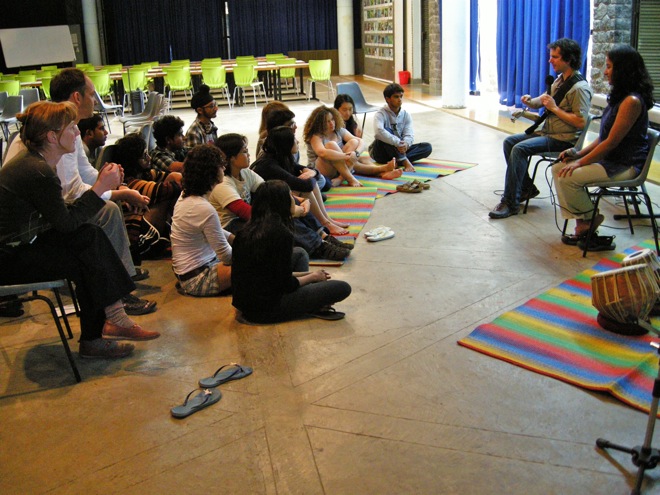
After the workshop we were given a tour of the grounds, including the herbal/medicinal garden and the biodiversity forest, where we stayed to watch a beautiful sunset.
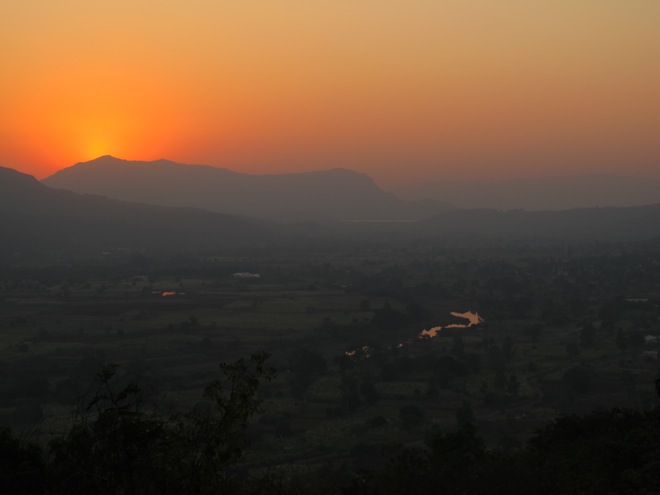
Our concert was fantastic, and the music was hot: hot enough that we blew out the PA system halfway through and had an unexpected intermission, followed by an a cappella solkattu piece, and the rest of the show. Suba sounded lovely despite a nasty cold, Ed got to try out his new tabla, and Dylan figured out how to make a borrowed high-school 4-string bass sound like his usual German-made 6-string bass. Many thanks to Ben and Sindhu for hosting our time at Mahindra UWC.

Our final day in Pune saw us at the National Film Archive of India, where Suba wanted to do some research for an upcoming Autorickshaw project. The National Film Archive of India was established as a media unit of the Ministry of Information and Broadcasting in February 1964. Its three principal objectives are
* To trace, acquire and preserve for posterity the heritage of Indian cinema;
* To classify, document data and undertake research relating to films;
* To act as a centre for the dissemination of film culture.
It has over 10,000 films, over 10,000 books, over 10,000 film scripts, and over 50,000 photographs.
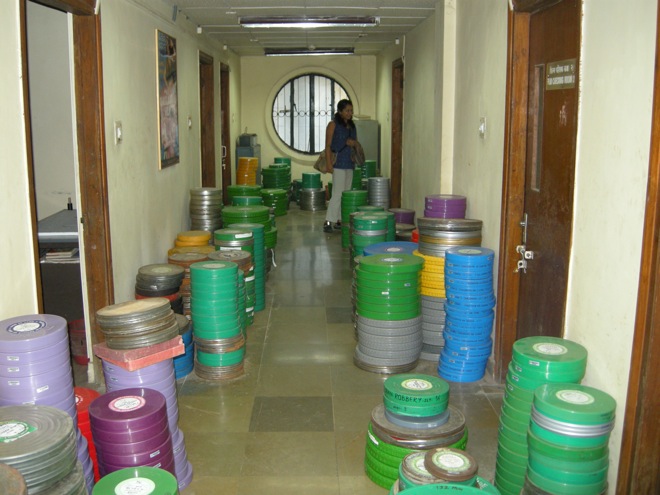
Don't worry. Most of the films aren't stored like this!
The place was fascinating, and it was exciting to meet people completely passionate about their work. It’s another place where the pictures do all the talking, so click here to see our/Ed’s blog/photo gallery.
Ed, Suba and Dylan go "Camping"!
So, on our last night in Pune, Ed decided to take us to the shopping district, just off MG (Mahatma Gandhi) Road. This area is known as Pune Camp, complete with fine dining, shopping complexes, corporate and commercial buildings, etc.
More than that, we were drawn in by the various street vendors, and our sampling included corn (roasted kernels with butter, salt, black pepper, white pepper, coriander, lime, and chilies), and lime soda (with real hand-squeezed lime juice).
And then there was Jai Shankar.
It doesn’t look like much from the outside. In fact, it’s a tiny hole-in-the-wall joint, but the place is packed with locals, the smells are divine, there is a buzzing energy filling the air around the stall, and we then get the distinct sense that we are approaching greatness of some kind in this very modest Pune Camp.
We all ordered Pani Puri: It comprises a round, hollow puri, fried crisp and filled with a mixture of water, tamarind, chili, chaat masala, potato, onion and chickpeas. It is small enough to fit completely in one's mouth.
Panipuri is served one at a time to each customer, round-robin style. Then the server gives a look and a Head Waggle to ask if any adjustments need to be made to the panipuri. * Remember that he asks this of every single customer and each customer might make an adjustment for the next round of panipuris being served. Servers have to remember each customer's preferences such as sweetened pani, more filling or extra onions, for example. The server must also keep count of how many panipuris each person has had. Panipuri servers are renowned for remembering choices and numbers served, even when serving an entire crowd (in our case, there were five of us standing around the server in a semicircle).
Back in Toronto, Suba was involved in a multimedia project called “Virtuosic Toronto”. In this project, a filmmaker documented the repetitive-yet-precise work of Toronto’s “everyday virtuosos”: coffee servers, shoe-shiners, and the like. Dancers and musicians then created a live visual and audio score to the film. Here at Jai Shankar, our server was beyond impressive with his know-how and his flair. After serving up panipuri after panipuri of mouth-watering, sweet and sour goodness, we recognized that he was the embodiment of Virtuosic Pune.
We wrapped up our excursion with our late-night meal, eating Chicken and Veg 65 at a local Durbar. Chicken 65 is a famous Indian delicacy… there was even a song written about it.
The next day we bid farewell to Ed and started our very long journey to Singapore.
Tune in to the next chapter, where Dylan and Suba rediscover modernity, sing in the old Singapore Parliament, and see a giant ship on top of a building. until then, click here to see a full photo gallery of our time in Pune.
Chapter 4: Singapore
3767 kilometers
18 hours of travel
one dozen soldiers armed with machine guns
11am departure
7am arrival
4 flights
2 very painful sinuses
1 radio interview, on…
0 hours of sleep
This pretty much sums up our travel day from Pune to Singapore. It’s not that far… about the same as travelling from Toronto to Vancouver. What could have been a single 5-hr flight instead became 4 flights, taking about 18 hrs door-to-door. Why? For you non-touring-musicians out there, let me explain the concept of “routing”.
Imagine performing in cities A, B, C, D, and imagine that they’re located in that order: east-west, north-south, or even in a circle. An ideal routing would have you travelling to those cities in that order. Nice, simple, and logical, right?
Except it never works out that way.
First of all, the organizers in these cities don’t even know each other, let alone have any ability to co-ordinate dates together. Second, they have what the pros call different “booking cycles”. Some presenters book concerts months or even a year in advance, while others book within mere weeks of the concert date. Then, add all the fun factors of booking flights, where prices can jump by hundreds of dollars in a matter of a day. Solution? Book the most-confirmed dates and longest flights as soon as you can, cross your fingers for a few, and suck up the rest.
This was our suck-it-up day.
We started with a 1-hr, cramped-as-hell autorickshaw ride to the Pune airport, followed by a flight to Chennai – with a stop in Bangalore to drop off and pick up more passengers (naturally, we had to stay on the plane). We had to leave ample time for potential flight delays, reclaiming baggage, and starting the whole process again at Chennai airport. Most of this time was spent figuring out how to get back in the airport for our international flight, past the guards with the machine guns. We got this sorted out, went through more levels of security than a missile silo (Chennai has some of the tightest security in the world), another gaggle of soldiers and guns, and a lengthy explanation of the electronics in our gear bag (which, admittedly, looks like some sort of spy-case), and on to… Colombo, Sri Lanka. Yes, We had to get from A to B via Q and Z. One bright spot: there’s a place in the Colombo airport that offers 20-minute head-and-shoulder Ayurvedic massages, and it was 20 minutes of heaven in an 18-hour travel day.
From here it was a relatively short jaunt to Singapore. Unfortunately, just short enough that we couldn’t sleep! Finally, we arrived in Singapore with all flights connected, our bags (and most of our sanity) intact, and poor Suba’s head-cold screaming bloody revenge after 8 take-off-and-landings.
But it didn’t end there. Since it was only 7:30am (5am India-time), we couldn’t check in or freshen up. And, of course, we had a radio interview at 10am. Just enough time for a quick coffee and breakfast (2 coffees for Dylan, just to remain upright), and a cab ride to the radio interview at 938Live. Fortunately it went very well, and Suba managed — barely — to stay awake.
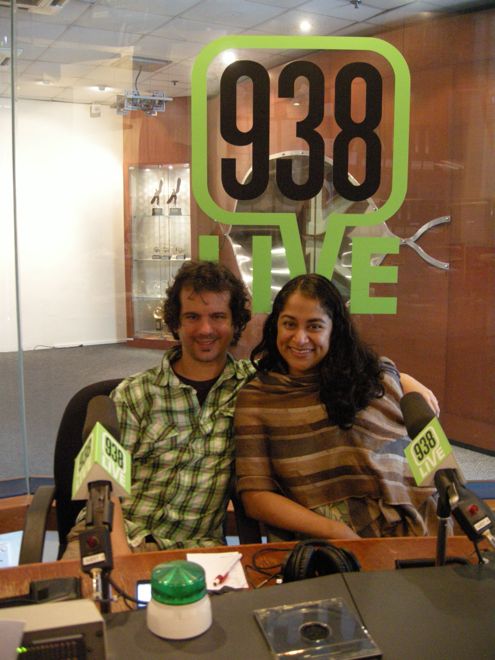
We checked in and settled in for a looooong, nap before our promo event later that evening at the Ngee Ann Centre, on Singapore’s famous shopping district, Orchard Road.

So, what about Singapore?
Singapore and India is a study in contrast:
- India is ancient. Singapore is modern.
- India’s beauty is in its profound, cradle-of-civilization culture. Singapore’s beauty is in its multiculturalism, it’s stunning modern architecture, and futuristic infrastructure.
- In Singapore, you are fined for spitting on the sidewalk. In India, spitting on the sidewalk is just fine.
- In Singapore, you can breathe the air. In India, you can chew it.
- In Singapore, getting things done is very easy. Case in point: while Suba was still napping, Dylan went next door, bought some dress pants, had a tailor alter them, bought a SIM card for his phone, and had a late lunch – all in under an hour, all in one building, and all for under $50.
- In India, well… [head-waggle].
We loved our time in India, and there is truly no place on earth like it. But it was nice to feel a semblance of modernity again.
The next day saw another radio interview, a particularly fun time with host Sara Wee, who is also a singer. The only downside: we couldn’t bring in our music equipment, cameras or cellphones: the radio station was located in the Ministry of Defence, and security was (yet again) extremely tight. Yup, that’s right: more soldiers.
January 15 was concert day, preceded by a workshop with the A Cappella Society’s youth group. The concert was held at the Arts House in the Old Parliament building… and it turns out our venue was the actual Parliament “Chamber”. Very cool!
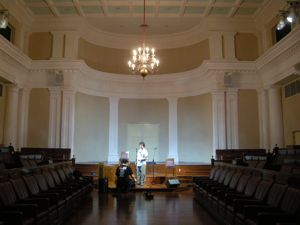

Our concert went very well, and our audience was small but mighty. We call the concert Inspired Eclecticism, and a look at our program will tell you why: we cover just about everything from Bach to Paul Simon, to Joni Mitchell, to a call-and response of Indian solkattu and contemporary vocal percussion. Add to this a combination of complex 2-part vocal arrangements and live, on-the-spot multitracking using live looping techniques, and you’ve got a pretty nice breadth of music for only two musicians. We also worked up a substantial amount of new music for this show.
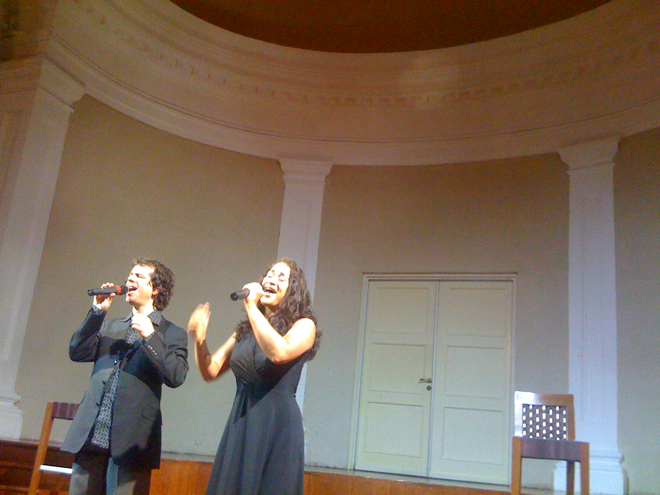
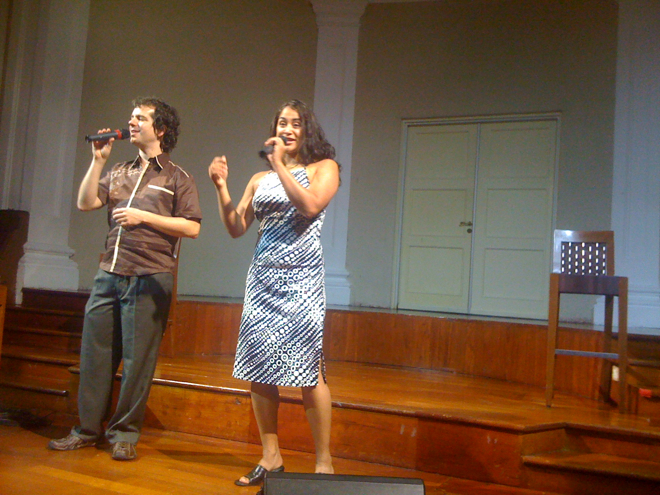
Unfortunately, we weren’t able to record it… but if you go to the “a cappella program” section on this site, you can see examples, taken from a concert last year at the River Run Centre in Guelph, Ontario.
You can take the Duo out of Canada, but you can’t take the Canadian out of the Duo. After our concert, we found a microbrewery on Clarke Quay and had our traditional post-concert talkdown/celebration over some fine beer. And true to our Canadian-ness, we went back again… twice.

From drinks to food…Singapore cuisine is a great representation of the ethnic diversity that is Singapore’s culture. Singapore’s geographic position allows for the easy import of many international food ingredients. From Malay to Chinese, Indian to Indonesian, Western to Middle Eastern, there is something for every palette. Most food is consumed at Food Courts (as opposed to restaurants) where the prices are cheap, the food abundant, excellent and made and served fresh. However, we move from the food courts to the restaurant circuit for this one important highlight: Annalakshmi.
Annalakshmi is a restaurant that follows the philosophy love, serve, give. It is a philosophy based on the Sanskrit adage, "athithi dhevo bhava" meaning “the guest is God” manifested through the service of largely voluntary staff. With ingredients prepared specially, each item on the menu reflects the ancient culinary art of India.
Wooden and marble statues of Ganesha (the elephant-faced Hindu God), Buddha and other deities line the walls of the restaurant, reflecting 4000 years of Indian visual arts, thus creating a real sensory and cultural experience while you eat. You can purchase the art on the walls too.
Yet another beautiful and unique feature of Annalakshmi is that there is no fixed price for the menu. It is an “Eat what you Want and Give as you Feel” concept.
To put the trust and responsibility in the customer is a beautiful thing, not dissimilar to those who offer pay-what-you-can or pay-what-you-want prices. Not only does Annalakshmi serve and give love and sustenance, they are bringing awareness of Indian culture, history, fine and culinary arts to all walks of life, and they are successfully bridging the gap between rich and poor.
I’d like to see more of this in our world.

Thanks to our host/presenter Angie Sassarak and my brother-in-law’s brother, Gopal, for introducing this amazing restaurant to us.
Our next two days were scheduled for workshops. The bad news… the workshops were cancelled due to low enrolment. The good news: we had more time for sightseeing, and a chance to visit family. Another place to let the pictures tell the story.
Click here to see our Singapore photo gallery
Also, we were fortunate enough to arrive in Singapore during the runup to Chinese New Year, which is celebrated in a big way. On one of our walks, we saw rehearsals for the International Lion Dance Competition. It’s amazing… check out the video below [coming soon]. The “Lion” — two acrobats in costume – has to walk/dance along a series of steps… about 15 feet off the ground. At about :35, you’ll see the Lion lose his footing… I have no idea how these guys managed to recover!
Many thanks to Angie and Alex Sassarak, (and David and Hana!) and all the folks at the A Cappella Society for making the concert and workshop happen. Singapore is beautiful, and we hope to come back soon.
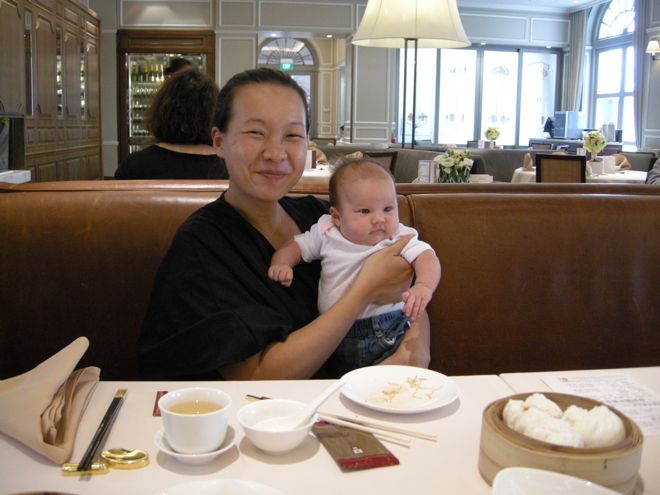
Angie and Baby Hana
Up next… Chapter 5: Bali. Tune in as Suba and Dylan become multimillionaires, go on a (temporary) raw-food diet, and learn to take it slow.
Chapter 5: Bali
At last, we had come to the end of our tour. Since we’d travelled more than 90% of the way there already, we decided to go “off the clock” and spend some vacation-time in Bali. When we changed money at the airport, we discovered that we were now multimillionaires!

Not so fast… the exchange rate is about 9000 rupiah to the dollar. Oh well.
Our first stop was Ubud, in central Bali. Ubud is known throughout the island, and throughout the world, as a place where people come to heal. Health spas – real ones, not just massage-and-manicure places – abound here, and there are numerous balians, a vocation somewhere between naturopathy and shamanism. (Apparently, there are more balian in Bali than doctors. Most Balinese will see the balian first… and balian and doctors regularly refer each other!)
While we didn’t see a balian here, we did stay at a health resort: Ubud Sari. Ubud Sari Health Resort is a place for those wishing to enhance mind, body and spirit in a picturesque, serene environment, but not in that Extreme Yoga or Bach-and-ocean-sounds kind of way. It is for the serious and hard-core health seekers wishing to detox, cleanse and purify their bodies. From simple a la carte massages and bodywork, to yoga and meditation classes, to 6-day fasting and healing treatments, there is something for everyone, and all treatments are done with great care and attention. Next time, we will plan ahead and commit to one of their programs.
The menu at Ubud Sari caters to all of their patrons, especially keeping in mind those that are coming off their fasting periods, so fresh raw foods (all vegetarian) and the most extensive list of organic juices are what the menu has to offer. This place was made for Suba! All of the ingredients – veggies, fruits, herbs – are literally from Ubud Sari’s backyard. At this point, Dylan the Carnivore would be expected to run screaming… but the menu was amazing. Imagine “pasta” made not of boiled flour thingies, but julienned pieces of raw coconut meat with the same texture as fettuccini, or a pesto pizza on a tender flax crust with tonnes of arugula and “cheese” made from cashew and macadamia nut shavings. Or… a sweet-chili basil avocado soup, light as air and full of flavour. It was mindbending to see what the chefs here could create.
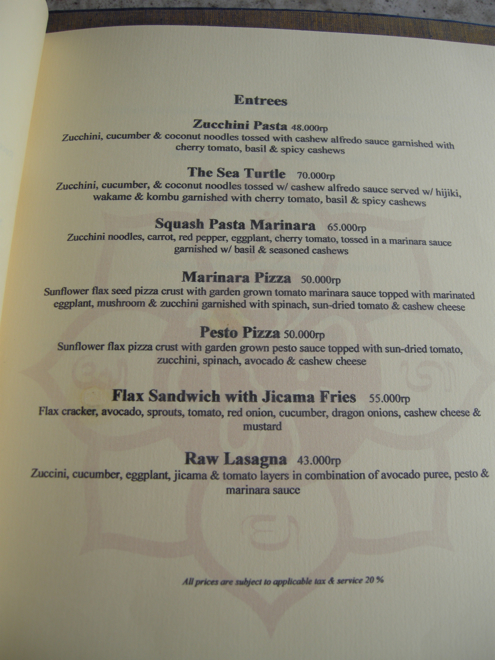
One bit of “work” we did while at Ubud Sari was the recording of a two-part a cappella version of Don McLean’s Vincent. Here’s the back story.
Suba is one of twelve resident artists at the Young Centre for the Performing Arts, under the fearless leadership of mastermind Albert Schultz. To celebrate the two-year anniversary of the Resident Artist program, fellow RA Noah Richler decided to plan a secret celebrate-Albert party with all of the RAs who were in town, some of the YC staff and Albert’s family. A few of us were on different continents, but Noah pursued the idea of us creating something from afar and sending it via cyberspace so that we could be there in voice and spirit. Thank the Gods and Goddesses for technology! Two days after the request, we created our two-part a cappella version of Vincent – one of the songs on the Albert play list, secretly obtained by Noah.
You can hear our version of Vincent here: recorded using the mic on our laptop, complete with Ubud fauna in the distance:
Vincent (D McLean), performed by Suba Sankaran and Dylan Bell
Thanks to Noah for spearheading the covert operation and everyone who was able to celebrate. And to Albert: thank you for being you, and for all that you do and give and make happen.
After a few days at Ubud Sari, it was inevitable that we’d run through all of the permutations of similar ingredients so we decided to take a half-day course on Balinese cooking.
For such a tightly-connected, communal society, food in Bali takes on a different role than you would imagine. First of all, eating is not really a social event. Forget Italian-like scenes of people around a giant table, breaking bread together for hours on end. In Bali people often eat alone, and they eat whenever they get hungry, not at prescribed times when everyone gathers together. Everything is made fresh daily. Food supplies are sourced early in the morning (markets are closed by 10am), and the lengthy preparation and cooking happens throughout the morning. All dishes for the whole day are made before lunchtime (the main meal for Balinese), and are available for people to nosh on for the rest of the day.
We started at a relatively-relaxed 8am with a market tour. Our guide and co-chef Oleg was fantastic in not only describing all the foods and ingredients, but in giving us insight on Balinese customs and cultures the whole way, and the subtle differences between Balinese and Indonesian cooking.
We came back to our cooking headquarters by late morning and had “second breakfast”, a collection of different delicious (and very sweet) snacks to fuel us up for the cooking procedure. But it’s not nearly as much fun to talk about food as it is to see it… so click here for a blow-by-blow photo gallery of what we learned to make.
Ubud is the also the cultural capital of Bali. It was always ruled by arts-friendly kings, and later on when things were getting rough with the Dutch colonialists, Ubud applied to be treated as a “Dutch protectorate”, allowing it to be spared in times of struggle. This allowed the arts to flourish for hundreds of years, and from the classic legends of the Ramayana brought from India in the 5th century to the influence of 20th-century expatriate European painters, it shows everywhere.
Naturally, we were primarily interested in the music. We’ve both had some experience with the main Indonesian musical style called gamelan. Suba has performed numerous times with Toronto’s Evergreen Club Contemporary Gamelan; Dylan took a course in Southeast Asian music in school, and composed a choral piece based on the Indonesian scale pelog. Gamelan music was everywhere in Ubud, from a casual practice in the community hall outside our first hotel, to a massive temple ceremony/street-parade which seemed to involve everyone in the city. Since Balinese music is often seen in the context of dance performances, we managed to see a couple of excellent shows.
The first one didn’t happen, at least at first, but involved an interesting side-story.
On our way to check out various dance venues, we came across a woman selling tickets. We bought them, had a nice Balinese (read: slow) dinner, and went to see the show. We were stopped by a guard on the way in who said “No show tonight. Someone died and they can’t use the temple”. When we asked about a refund, he said “try the woman at the restaurant over there”. We hadn’t bought our tickets from her, so no dice.
We started home, saddened that someone had passed away, disappointed that we wouldn’t see a show tonight, and a little concerned that perhaps the ticket seller had scammed us. We heard someone calling from behind us. We were just about to give her the brush-off, assuming it was yet another street-hawker, when we realized it was our ticket seller: she had gone to the venue to try to find us, and hunted us down on the street on a moped. She gave us back our money and asked us to come tomorrow night. Humbled by her honesty and perseverance in finding us, we said we would. “Come find me to buy tickets”, she said. “You know where, yes?”
True to our word, we came back the next night and found her on the same stoop. But the story got better: not only was she selling tickets, she was one of the singers in the show! We thanked her and told her we’d look forward to seeing her perform.
The show we had come to see had a combination of dances, all performed with the dancers or singers in a trance-like state. The first was the kecak, and it was fascinating. It’s performed a cappella, with the singers seated in concentric circles, and most of it isn’t singing, but rhythmically-complex, interlocking chanting of “chak-chak-a-chak”. Why? The story behind the dance concerns (in part) the Monkey God, and the singers represent the monkeys in the forest. In addition, the singers weave and sway in eerie, school-of-fish-like precision and one-mindedness. To read a more detailed description, click here.
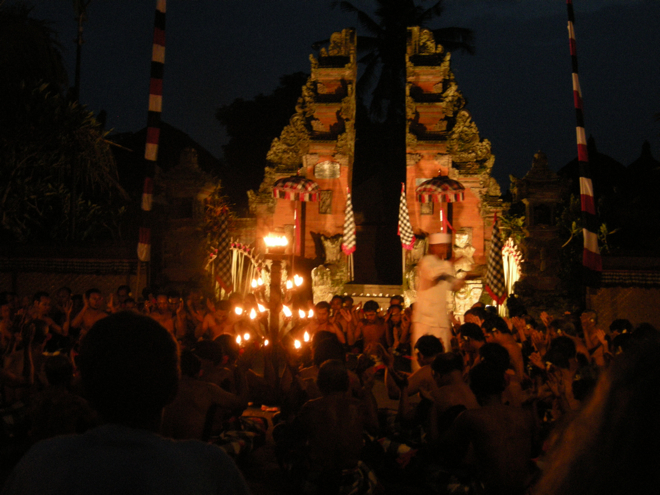
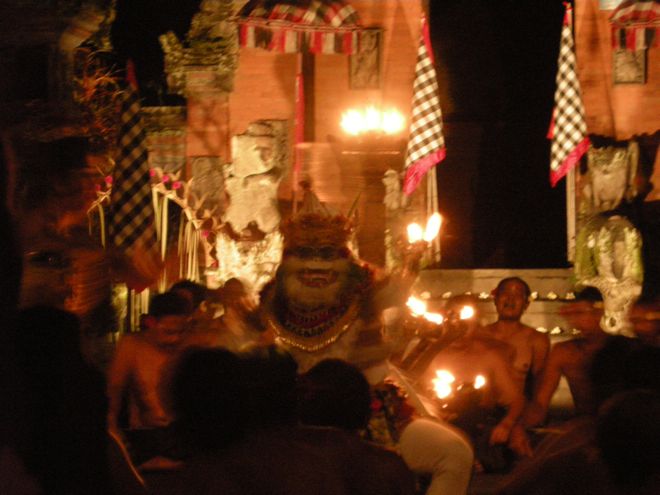
Next up was a dance with two young girls, also in a trance, who performed a graceful dance to the Gods in perfect sync… with their eyes closed the entire time. Our ticket seller was one of several female singers who accompanied this one. After the dance was finished the girls had to be revived and gently led from the stage.
The final dance was one of those things you hear about, but don’t really believe until you see it. A pile of coconut husks was lit on fire, and the coals scattered. A dancer came out with a hobby-horse like prop and “rode” it around the circle. He too was in a trance, and when you hear what’s next, you’ll be glad he was.
He rode his hobby-horse, galloping around in his bare feet… then kicked the burning coals… then stepped through them and upon them as he galloped. Helpers re-gathered the coals, and he did it again. Several times. At the end of the dance he sat down, slowly coming out of his trance. Tourists came to feel his blackened feet. No tricks, no gimmicks… this was the real deal.


The next performance we saw was thanks to our dear friends Ken Shorley and Heidi Kalyani. Ken is a longtime student of Suba’s father and a fantastic percussionist, and he and Heidi came to Ubud for an intensive Balinese-culture course in 2009. Suba wrote to Ken asking where to see the best gamelan in town, and we got his answer the day of their performance. Ken described the Semara Ratih as a mix of traditional and modern gamelan, and a cut above most of what he saw here. He was right on the money. Since we don’t have recordings, here’s a photo gallery of the show and the dances.
They say Bali is one of those places where time seems to lose all meaning, and it’s true. For the first few days, it took some time to adjust from the constant travel and fast pace we had become accustomed to touring India and Singapore. But eventually, we found ourselves seduced by the rhythm of Balinese time. We had deliberately left this part of the trip open, so we could play it by ear. We planned to stay in Ubud for 5 to 7 days. We stayed for 9. This might help explain why.

For our last few days, we decided to go to Sanur for some quiet, beach-and-book-reading time before heading back to a very tight work schedule back in Toronto. As we write this, it’s our final night, and the monsoon is in full force. We’ve decided that it’s Bali’s way of saying it’s OK for us to go. But take a look at this photo gallery, and you’ll see why it’s so hard to leave.
Tomorrow we rise at 6am for a flight to Singapore, a whirlwind 15-hour stopover for some last-minute Singapore shopping (and a final pre-flight massage!), and 1am flight beginning our long, journey home.
Many thanks again to all those who helped make this tour possible: Virgil, Ben and Sindhu, Angie and Alex, and the Singapore crew. We know we’ll see you all again. Thanks to Ed for making us a trio in Pune, and for giving us a place to stay. Thanks especially to the Ontario Arts Council: your support made this tour possible. And thanks to all the new friends and fans we’ve met along the way. Please stay in touch!
Here endeth the Blog. Join us in May, when Dylan and Suba head back to Europe!